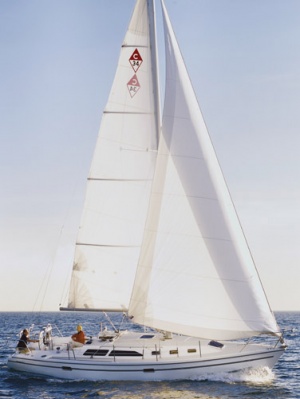Difference between revisions of "V Berth Louvered Doors"
| Line 1: | Line 1: | ||
| − | == | + | ==V berth insert modification== |
| + | '''By Lance Jones, ''Kitty's Cat'' #622 (1988)''' | ||
| − | + | [[image:PLACEHOLDER-C34.jpg|thumb|300px|Placeholder caption here]] | |
| + | For those of you who have added Dan Harrington's excellent project for under V-berth storage (http://www.c34ia.org/wiki/index.php?title=V_Berth_Louvered_Doors) but, still want to be able to lower the V-berth insert to the mid level, I did the following modification that you may be interested in. | ||
| − | + | ====Tools & Materials==== | |
| − | + | Tools: Saw, Measuring Tape, Pencil (or some other type marker), Straight Edge, Drill, #10 Screw pilot & counter-sink, Phillips screw driver or same type bit for drill. | |
| − | + | Materials: 1x2 inch strip of teak or other suitable material, Masking Tape, Eight 1 1/2 inch #10 wood or self tapping screws (using #10 bolts is an option too) | |
| − | + | ====Procedure==== | |
| + | Step 1. Locate molded-in ledge that the V-berth insert rests on in the mid-position. | ||
| − | + | Step 2. Measure both the starboard and port lips. They are different lengths. | |
| − | |||
| − | |||
| − | |||
| − | |||
| + | Step 3. Cut your teak to the appropriate length. I added about 1/2 inch to mine and transferred the angle on the corner of the ledge to the wood. | ||
| − | + | Step 4. Determine screw hole locations. I evenly spaced 4 screws on each slat. Then drill them out using the pilot drill and counter-sink. | |
| − | + | ||
| − | + | Step 5. I taped my two pieces in their respective locations and then used the holes to drill through the fiberglass underneath to insure proper alignment. | |
| + | |||
| + | Step 6. Insert the screws and then seat them with your screw driver or drill. | ||
| + | |||
| + | Step 7. Enjoy the full use of your V-berth insert. (Note) you will have to remove the insert to open and close the doors. | ||
| + | |||
| + | ====Side notes==== | ||
| + | I'm a pack rat -- especially when it comes to teak. So, for this project, I used the teak from one of my old C-22s that was used on the companion way to slide the crib boards in. They are ideal for this project as the are L-shaped and have a lot of strength. | ||
| + | |||
| + | I have not completed this project yet as I have to finish the wood with Cetol and then reinstall. However, until then, they will continue to be used in their unfinished, weathered condition. I'll add a picture soon too. | ||
Revision as of 17:56, 30 December 2009
V berth insert modification
By Lance Jones, Kitty's Cat #622 (1988)
For those of you who have added Dan Harrington's excellent project for under V-berth storage (http://www.c34ia.org/wiki/index.php?title=V_Berth_Louvered_Doors) but, still want to be able to lower the V-berth insert to the mid level, I did the following modification that you may be interested in.
Tools & Materials
Tools: Saw, Measuring Tape, Pencil (or some other type marker), Straight Edge, Drill, #10 Screw pilot & counter-sink, Phillips screw driver or same type bit for drill.
Materials: 1x2 inch strip of teak or other suitable material, Masking Tape, Eight 1 1/2 inch #10 wood or self tapping screws (using #10 bolts is an option too)
Procedure
Step 1. Locate molded-in ledge that the V-berth insert rests on in the mid-position.
Step 2. Measure both the starboard and port lips. They are different lengths.
Step 3. Cut your teak to the appropriate length. I added about 1/2 inch to mine and transferred the angle on the corner of the ledge to the wood.
Step 4. Determine screw hole locations. I evenly spaced 4 screws on each slat. Then drill them out using the pilot drill and counter-sink.
Step 5. I taped my two pieces in their respective locations and then used the holes to drill through the fiberglass underneath to insure proper alignment.
Step 6. Insert the screws and then seat them with your screw driver or drill.
Step 7. Enjoy the full use of your V-berth insert. (Note) you will have to remove the insert to open and close the doors.
Side notes
I'm a pack rat -- especially when it comes to teak. So, for this project, I used the teak from one of my old C-22s that was used on the companion way to slide the crib boards in. They are ideal for this project as the are L-shaped and have a lot of strength.
I have not completed this project yet as I have to finish the wood with Cetol and then reinstall. However, until then, they will continue to be used in their unfinished, weathered condition. I'll add a picture soon too.
